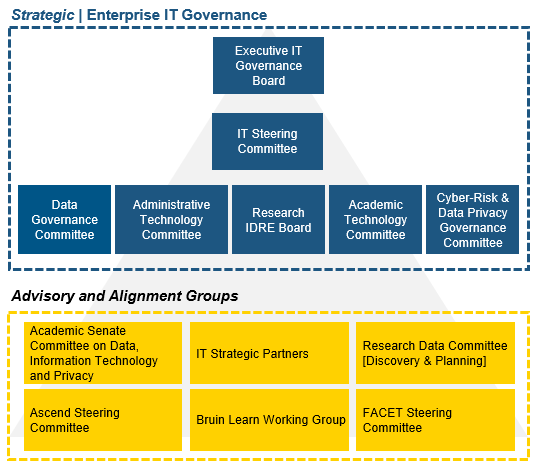
Introduction
As a vibrant and expansive center for learning and discovery, UCLA requires a dynamic information technology ecosystem. With the large array of technology units across campus, serving varied needs is a highly collaborative, coordinated effort. Diverse perspectives are critical to understanding complex issues and ensuring proposals and decisions are context-aware, relevant, and productive. As a steward of IT governance, the Office of Chief Information Officer (OCIO) strives to facilitate the crucial level of consensus, visibility, and voice necessary for successful campus IT governance.
The campus IT governance process is an inclusive approach to developing and implementing campus-wide technology strategy, policy, and solutions that advance the university’s mission of teaching, research, and public service. The IT governance process relies on a collective of established committees with the domain expertise to inform IT strategy, bring forth well-formed, thoughtful proposals for review and approval, and ultimately provide the university with valuable, consistent, and transformative services.
IT Governance Structure

Strategic Enterprise IT Governance
UCLA’s IT governance is driven by collective decision-making and an unyielding commitment to excellence. The strategic core of the governance structure consists of the Executive IT Governance Board, IT Steering Committee, and five domain-specific committees. These groups, while focused on particular aspects of IT governance, collectively work to inform, shape, and guide the vision, direction, and priorities for campus technology.
Advisory and Alignment Groups
Advisory and alignment groups across campus serve an important role by informing and supporting technology-related projects and initiatives. These groups vary in structure, scope, function, and tenure. Examples include standing committees, project-specific steering committees, and temporary working groups.
Members of advisory and alignment groups may formally serve on the domain-specific committees or informally share concerns and insights with the domain-specific committees. This promotes dialogue and robust cross-pollination of expertise and ideas across various communication channels.
